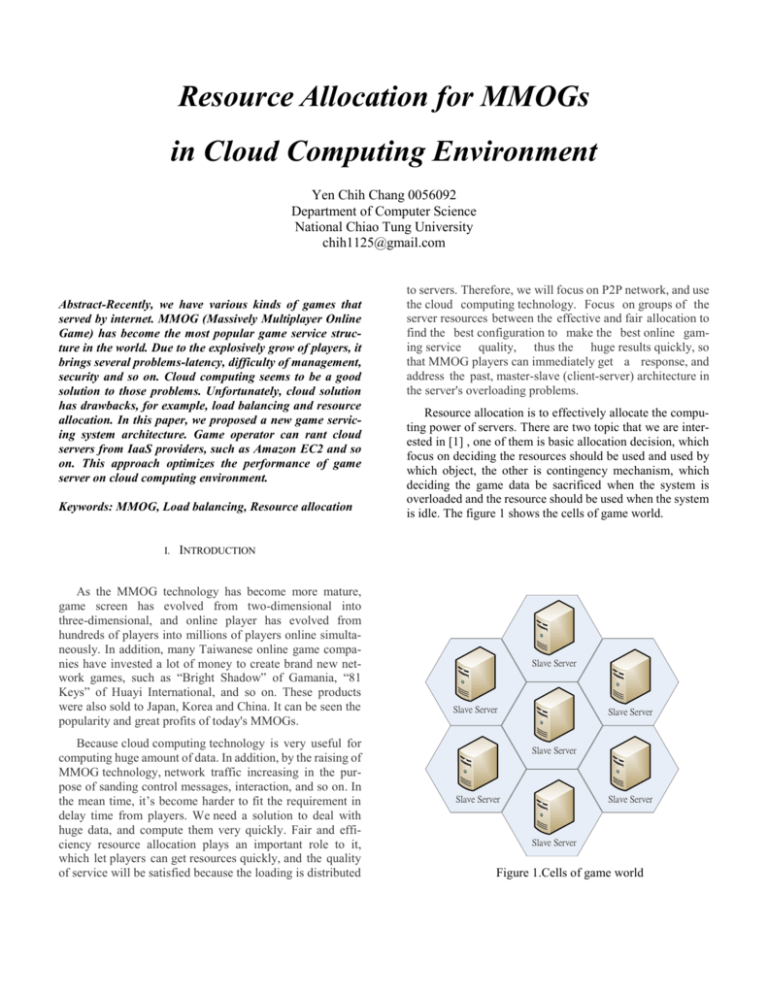Resource Allocation for MMOGs in Cloud Computing Environment
advertisement

Resource Allocation for MMOGs in Cloud Computing Environment Yen Chih Chang 0056092 Department of Computer Science National Chiao Tung University chih1125@gmail.com Abstract-Recently, we have various kinds of games that served by internet. MMOG (Massively Multiplayer Online Game) has become the most popular game service structure in the world. Due to the explosively grow of players, it brings several problems-latency, difficulty of management, security and so on. Cloud computing seems to be a good solution to those problems. Unfortunately, cloud solution has drawbacks, for example, load balancing and resource allocation. In this paper, we proposed a new game servicing system architecture. Game operator can rant cloud servers from IaaS providers, such as Amazon EC2 and so on. This approach optimizes the performance of game server on cloud computing environment. Keywords: MMOG, Load balancing, Resource allocation I. to servers. Therefore, we will focus on P2P network, and use the cloud computing technology. Focus on groups of the server resources between the effective and fair allocation to find the best configuration to make the best online gaming service quality, thus the huge results quickly, so that MMOG players can immediately get a response, and address the past, master-slave (client-server) architecture in the server's overloading problems. Resource allocation is to effectively allocate the computing power of servers. There are two topic that we are interested in [1] , one of them is basic allocation decision, which focus on deciding the resources should be used and used by which object, the other is contingency mechanism, which deciding the game data be sacrificed when the system is overloaded and the resource should be used when the system is idle. The figure 1 shows the cells of game world. INTRODUCTION As the MMOG technology has become more mature, game screen has evolved from two-dimensional into three-dimensional, and online player has evolved from hundreds of players into millions of players online simultaneously. In addition, many Taiwanese online game companies have invested a lot of money to create brand new network games, such as “Bright Shadow” of Gamania, “81 Keys” of Huayi International, and so on. These products were also sold to Japan, Korea and China. It can be seen the popularity and great profits of today's MMOGs. Because cloud computing technology is very useful for computing huge amount of data. In addition, by the raising of MMOG technology, network traffic increasing in the purpose of sanding control messages, interaction, and so on. In the mean time, it’s become harder to fit the requirement in delay time from players. We need a solution to deal with huge data, and compute them very quickly. Fair and efficiency resource allocation plays an important role to it, which let players can get resources quickly, and the quality of service will be satisfied because the loading is distributed Slave Server Slave Server Slave Server Slave Server Slave Server Slave Server Slave Server Figure 1.Cells of game world II. LITERATURE REVIEW A. Load balancing Vlad Nae et al. in their paper “Efficient Management of Data Center Resources for Massively Multiplayer Online Games” discusses about 8 kinds of load prediction approach [6], includes the neural network approach. They also use 4 attributes to generate the simulation data of players. The 4 attributes is aggressive, team, scout and camp, and combine them together into 8 combinations, shown on table 1. In their opinion, neural network is the best load prediction approach in every situation, the emulation result is shows in figure 2. Table 1.Configuration parameters for obtaining the eight trace data sets through emulation. Data set 1 2 3 4 5 6 7 8 Player behavior (%) Aggr. Scout Team Camp 80 10 0 10 60 10 0 20 70 20 0 10 70 30 0 0 30 40 30 0 10 80 10 0 20 40 40 0 20 80 0 0 Peak Hours No No No No Yes Yes Yes Yes Figure 2.The accuracy of 7 prediction algorithms applied to MMOG data On the other hand, in our laboratory, we have some research about resource allocation and load balancing for MMOGs in cloud computing environment. Figure 3 classifies our works, we briefly introduce each category. An Efficient Hybrid P2P MMOG Cloud Architecture for Dynamic Load Management (Gin-Hung) B. Resource allocation Resource allocation is the main topic of this proposal. We have two works about this topic. One of them is proposed by Chen-Fung et al. [3], which is neural network approach. There two phases in their method: load prediction phase and resource allocation phase. It predicts the servers loading by neural network. They collect historical game data which includes CPU, memory and network loads from a popular MMOG, Lineage. This solution has good accuracy, fair, and good ambiguous inference ability, but with high overhead and longer training time [3]. Another one is SVM based approach that proposed by Zhao-Lin et al. [4], a support vector machine (SVM) is a concept in statistics and computer science for a set of related supervised learning methods that analyze data and recognize patterns, used for classification and regression analysis [5]. In this thesis, they have presented an efficient SVM-based load prediction scheme for resource allocation in MMOG clouds. They also use historic load data of players in each region to predict the future load. By using the load prediction results, they can allocate (or release) an appropriate number of virtual machines to each game region in advance in an MMOG cloud so as to meet the response time requirement of each player and to have better resource utilization in MMOG clouds [4]. We perform a comparison of these two approaches, which shows on Table 2. Table 2.Comparison of SVM approach and neural network approach MMOGs in Cloud Computing Environments Load Balancing Gin-hung et al. proposed a load prediction algorithm. In [2], they allocate VMs from game servers to service game regions. Game regions do not setup on specific virtual machines. In this way, it could help the system to get high scalability. They do not use a single master server in the game servers cloud, Game servers communication is based on a P2P protocol. Game servers can exchange load information by flooding in the P2P protocol. Game servers can perform load management by themselves, and a game server is also in charge of creating accounts for players when they login for the first time. This way can help resource allocation more efficient. [2] Resource Allocation (Load Predict) Neural Network SVM Dynamic Resource Allocation for MMOGs in Cloud Computing Environments (Chen-Fung) SVM-based load prediction for resource allocation in MMOG clouds (Zhao-Lin) Figure 3.The classification of MBL works on MMOGs Accuracy Fairness Overhead Training time Compatibility to data Ambiguous inference SVM based approach Good Yes Low Shorter Worse Neural network approach Good Yes High Longer Good No Yes III. DESIGN APPROACH In this section, we would like to introduce new system architecture for game services. This approach is designed for cloud information system, requires VM support to operate gaming service. The virtual game world is composed by many regions. In our design, the computing of a region is done by a VM instance called region server (RS). When a player login, system will initialize a VM instance to serve this player, which called avatar server (AS) . Each avatar server will be placed with the region server which this avatar at. The reason why we put them together is to reduce the traffic overhead, because each avatar server will communicate with its region server very frequently. Furthermore, if the avatar is moving across a long distance that too long so need to perform VM migration, we can predict player’s destination by his or her behavior (direction or even they talking about). The system architecture is shown on Figure 4. This design satisfies the five characteristics of cloud computing: I. Rapid elasticity: We can give or retrieve resources for each avatar server and region server very quickly. II. Measured service: We must measure the loading of every avatar server and region server to provide correct amount of resources to them. III. On-demand self-service: The allocation of resources is automatic, need not to call the system administrator, it can be done directly. IV. Broad network access: When the game is proceeding, the avatar server is responsible to receive the instructions from player, then to compute the change due to these instructions, and encode the display information into stream packets to send back to player. All things a player needs are network accessibility and a device that can interact with avatar server. V. Resource pooling: All of the resources are under centralized management. Compare with the traditional cloud gaming architecture, by leveraging the strength of virtualization technology, this architecture is easier to deploy on cloud servers of IaaS service providers. We also integrate some function of traditional game server and graphics computing unit into an AS, reducing huge amount of networking traffic, reserving network resources to video streaming, in other words, achieving better network utilization. IV. Figure 4. The system architecture we proposed When a player is logged out, the system will take a snapshot of the VM instance and put it to the database, stored as an image. This design is able to allocate resource player by player. Each player is a VM instance in the game server, by the adjustment of the resource that avatar server have, to perform change of computing capability of each player. Not only a player but a region can perform this kind of adjustment. In this case, we don’t have to observe the player’s behavior and to create a resource allocation policy to fit them. The only thing that game operator have to do is to measure the loading of each VM instance, and use a load predictor to foresee the resource this VM instance may need, then adjust the capability of the VM. CONCLUSION In this paper, we discussed couple of theses concerning about resource allocation of MMOGs in cloud computing environment. Cloud computing technology creates a possibility to offload most computation to the server. In the meantime, how to allocate the limited resource is getting more important. We expected the new approach will be fast, easy to implement and the most important, without heavy computation overhead. V. REFERENCE [1]K.-W. Lee, B.-J. Ko, and S. Calo, "Adaptive server selection for large scale interactive online games," in Proceedings of Computer Networks, vol. 49, pp. 84-102, September 2005. [2] Gin-Hung Wang, Kuo-Chen Wang, “An efficient hybrid P2P MMOG cloud architecture for dynamic load manage- ment.” Institutes of Network Engineering, National Chiao Tung University [3] Chen-Fang Weng, Kuo-Chen Wang, “Dynamic resource allocation for MMOGs in cloud computing environment.” Institutes of Network Engineering, National Chiao Tung University [4] Zhao-Lin Wu, Kuo-Chen Wang, “SVM-based load prediction for resource allocation in MMOG clouds.” Institutes of Network Engineering, National Chiao Tung University [5] http://en.wikipedia.org/wiki/Support_vector_machine [6] Vlad Nae, Alexandru Iosup, Stefan Podlipnig, Radu Prodan, Dick Epema, and Thomas Fahringer, “Efficient Management of Data Center Resources for Massively Multiplayer Online Games”, Institute for Computer Science, University of Innsbruck








